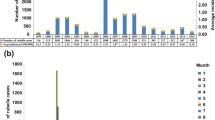Abstract
In light of two rubella outbreaks in northern Greece during the last decade (1993 and 1999) and periodic changes to the immunization strategy, the present study was conducted to determine the current status of rubella immunity in this region. Among the 729 subjects studied the total vaccination rate was 30.4% and the seroprevalence rate was 82.4% (odds ratio, 0.618; 95% confidence interval, 0.415–0.921). A higher seroprevalence (83.2%) was observed among people born before 1989, when the national rubella immunization program was introduced, compared to the individuals born after 1989 (67.1%; P=0.000). Among women of reproductive age (i.e. 16–40 years), who represented 69.6% of the study population, 10.3% were susceptible to rubella and only 16.4% were vaccinated. The results indicate a comprehensive policy is still needed in order to eliminate rubella and congenital rubella syndrome in Greece.
Similar content being viewed by others
References
Cooper LZ (1985) The history and medical consequences of rubella. Rev Infect Dis 7(Suppl 1):2–10
Miller E, Cradock-Watson JE, Pollock TM (1982) Consequences of confirmed maternal rubella at successive stages of pregnancy. Lancet 2:781–784
Miller C, Miller E, Sequeira P et al (1985) Effect of selective vaccination on rubella susceptibility and infection in pregnancy. Br Med J 291:1398–1401
Panagiotopoulos T, Antoniadou I, Valassi-Adam E (1999) Increase in congenital rubella occurrence after immunization in Greece: retrospective survey and systematic review. Br Med J 319:1462–1467
Tsagaropoulou-Stigga H (2000) The MMR vaccine. Vaccines in Greece. Hellenic Pediatric Society, Thessaloniki
Institute of Child Health (2002) http://www.ich.gr/rd_emvoliasm.html (last accessed 16 June 2004)
Keramida-Karamitsou P, Edipidis T (1972) Frequency of rubella antibodies among children 5–12 years old. Acta Microbiologica Hellenica 17:109–115
Keramida-Karamitsou P (1971) The importance of detecting antibodies against rebella virus in females. Thesis. Aristotle University of Thessaloniki (in Greek)
Andrews N et al (2000) The European Sero-Epidemiology Network: standardizing the enzyme immunoassay results for measles, mumps and rubella. Epidemiol Infect 125:127–141
Kyriazopoulou V, Frantzidou F, Diza E, Souliou E (1995) Recent techniques used for rubella diagnosis. Progress or confusion? Acta Microbiologica Hellenica 40:34–39
Centers for Disease Control (1970) Standard rubella haemagglutination inhibition test. US Public Health Service, Washington DC, Publication number 17
Panagiotopoulos T, Antoniadou I, Antonopoulou E et al (1996) Increase of age at infection in Attiki (Greece) during the rubella epidemic of 1993. Arch Hellenic Med 13:211–219
Author information
Authors and Affiliations
Corresponding author
Rights and permissions
About this article
Cite this article
Gioula, G., Diza-Mataftsi, E., Alexiou-Daniel, S. et al. Seroepidemiology of rubella in northern Greece. Eur J Clin Microbiol Infect Dis 23, 631–633 (2004). https://doi.org/10.1007/s10096-004-1172-y
Published:
Issue Date:
DOI: https://doi.org/10.1007/s10096-004-1172-y




